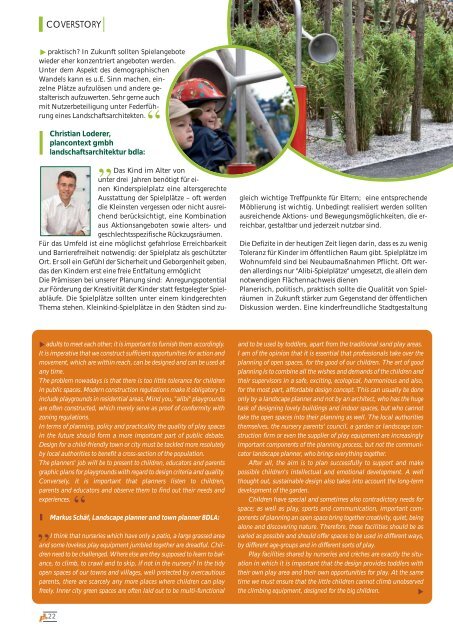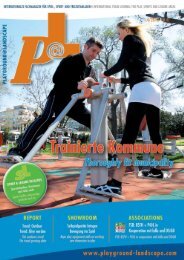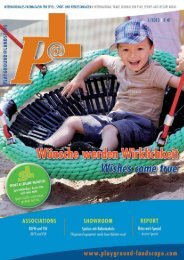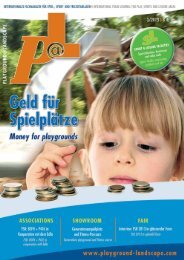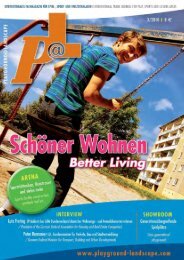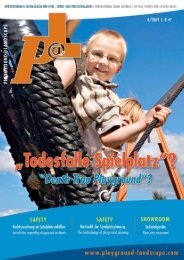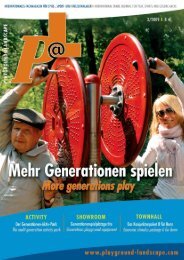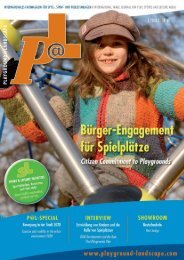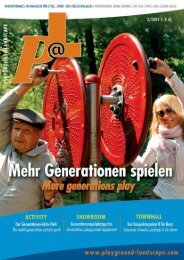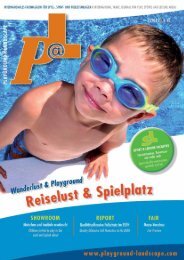Download - Playground@Landscape
Download - Playground@Landscape
Download - Playground@Landscape
Sie wollen auch ein ePaper? Erhöhen Sie die Reichweite Ihrer Titel.
YUMPU macht aus Druck-PDFs automatisch weboptimierte ePaper, die Google liebt.
COVERSTORY<br />
praktisch? In Zukunft sollten Spielangebote<br />
wieder eher konzentriert angeboten werden.<br />
Unter dem Aspekt des demographischen<br />
Wandels kann es u.E. Sinn machen, einzelne<br />
Plätze aufzulösen und andere gestalterisch<br />
aufzuwerten. Sehr gerne auch<br />
mit Nutzerbeteiligung unter Federführung<br />
eines Landschaftsarchitekten.<br />
Christian Loderer,<br />
plancontext gmbh<br />
landschaftsarchitektur bdla:<br />
Das Kind im Alter von<br />
unter drei Jahren benötigt für einen<br />
Kinderspielplatz eine altersgerechte<br />
Ausstattung der Spielplätze – oft werden<br />
die Kleinsten vergessen oder nicht ausreichend<br />
berücksichtigt, eine Kombination<br />
aus Aktionsangeboten sowie alters- und<br />
geschlechtsspezifische Rückzugsräumen.<br />
Für das Umfeld ist eine möglichst gefahrlose Erreichbarkeit<br />
und Barrierefreiheit notwendig: der Spielplatz als geschützter<br />
Ort. Er soll ein Gefühl der Sicherheit und Geborgenheit geben,<br />
das den Kindern erst eine freie Entfaltung ermöglicht<br />
Die Prämissen bei unserer Planung sind: Anregungspotential<br />
zur Förderung der Kreativität der Kinder statt festgelegter Spielabläufe.<br />
Die Spielplätze sollten unter einem kindgerechten<br />
Thema stehen. Kleinkind-Spielplätze in den Städten sind zugleich<br />
wichtige Treffpunkte für Eltern; eine entsprechende<br />
Möblierung ist wichtig. Unbedingt realisiert werden sollten<br />
ausreichende Aktions- und Bewegungsmöglichkeiten, die erreichbar,<br />
gestaltbar und jederzeit nutzbar sind.<br />
Die Defizite in der heutigen Zeit liegen darin, dass es zu wenig<br />
Toleranz für Kinder im öffentlichen Raum gibt. Spielplätze im<br />
Wohnumfeld sind bei Neubaumaßnahmen Pflicht. Oft werden<br />
allerdings nur "Alibi-Spielplätze" umgesetzt, die allein dem<br />
notwendigen Flächennachweis dienen<br />
Planerisch, politisch, praktisch sollte die Qualität von Spielräumen<br />
in Zukunft stärker zum Gegenstand der öffentlichen<br />
Diskussion werden. Eine kinderfreundliche Stadtgestaltung<br />
adults to meet each other; it is important to furnish them accordingly.<br />
It is imperative that we construct sufficient opportunities for action and<br />
movement, which are within reach, can be designed and can be used at<br />
any time.<br />
The problem nowadays is that there is too little tolerance for children<br />
in public spaces. Modern construction regulations make it obligatory to<br />
include playgrounds in residential areas. Mind you, "alibi" playgrounds<br />
are often constructed, which merely serve as proof of conformity with<br />
zoning regulations.<br />
In terms of planning, policy and practicality the quality of play spaces<br />
in the future should form a more important part of public debate.<br />
Design for a child-friendly town or city must be tackled more resolutely<br />
by local authorities to benefit a cross-section of the population.<br />
The planners' job will be to present to children, educators and parents<br />
graphic plans for playgrounds with regard to design criteria and quality.<br />
Conversely, it is important that planners listen to children,<br />
parents and educators and observe them to find out their needs and<br />
experiences.<br />
Markus Schäf, Landscape planner and town planner BDLA:<br />
I think that nurseries which have only a patio, a large grassed area<br />
and some loveless play equipment jumbled together are dreadful. Children<br />
need to be challenged. Where else are they supposed to learn to balance,<br />
to climb, to crawl and to skip, if not in the nursery? In the tidy<br />
open spaces of our towns and villages, well protected by overcautious<br />
parents, there are scarcely any more places where children can play<br />
freely. Inner city green spaces are often laid out to be multi-functional<br />
and to be used by toddlers, apart from the traditional sand play areas.<br />
I am of the opinion that it is essential that professionals take over the<br />
planning of open spaces, for the good of our children. The art of good<br />
planning is to combine all the wishes and demands of the children and<br />
their supervisors in a safe, exciting, ecological, harmonious and also,<br />
for the most part, affordable design concept. This can usually be done<br />
only by a landscape planner and not by an architect, who has the huge<br />
task of designing lovely buildings and indoor spaces, but who cannot<br />
take the open spaces into their planning as well. The local authorities<br />
themselves, the nursery parents' council, a garden or landscape construction<br />
firm or even the supplier of play equipment are increasingly<br />
important components of the planning process, but not the communicator<br />
landscape planner, who brings everything together.<br />
After all, the aim is to plan successfully to support and make<br />
possible children's intellectual and emotional development. A well<br />
thought out, sustainable design also takes into account the long-term<br />
development of the garden.<br />
Children have special and sometimes also contradictory needs for<br />
space; as well as play, sports and communication, important components<br />
of planning an open space bring together creativity, quiet, being<br />
alone and discovering nature. Therefore, these facilities should be as<br />
varied as possible and should offer spaces to be used in different ways,<br />
by different age-groups and in different sorts of play.<br />
Play facilities shared by nurseries and crèches are exactly the situation<br />
in which it is important that the design provides toddlers with<br />
their own play area and their own opportunities for play. At the same<br />
time we must ensure that the little children cannot climb unobserved<br />
the climbing equipment, designed for the big children.<br />
22


